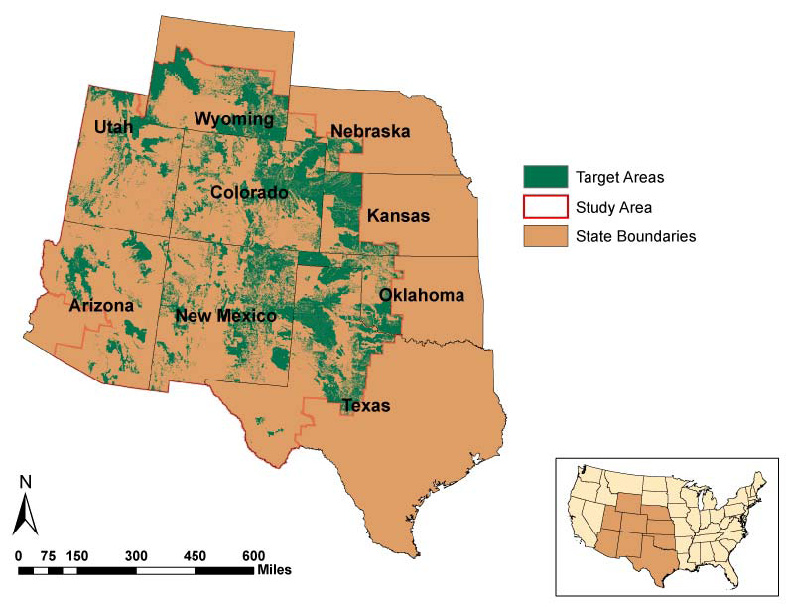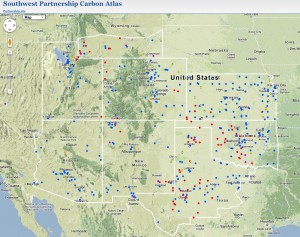Category Archives: The Southwest Partnership
Quarterly Reports
Our quarterly reports are not available to the public. Much of the data and information in these reports is preliminary and subject to further analysis and interpretation, and some material is proprietary. However, we have made the Executive Summaries and Table of Contents for each quarterly available.
The Southwest Partnership
Southwest Partnership Projects
The Southwest Partnership’s effort has focused on three Phases, all based upon the mandate of the National Energy Technology Laboratory. As one of seven regional carbon partnerships, it has been tasked to determine the best geologic and terrestrial carbon management approaches that may help to store or better utilize captured CO2 in a commercial scale.
The Southwest Region
The Southwest Region of the United States is energy-rich, with some of the largest energy-production growth rates in the nation. Two major pipeline networks transport more than 32 million metric tons (35 million tons) per year of natural subsurface CO2 to petroleum fields throughout the southwest and mountain states, where it is used for enhanced oil recovery (EOR). Naturally occurring CO2 is found in reservoirs in many western states, including New Mexico, Colorado, and Arizona. In addition to natural sources, the 10 largest coal-fired power plants in the region produce about 125 million metric tons (138 million tons) per year. Other stationary sources include natural gas processing plants, refineries, and ammonia/fertilizer, ethylene and ethanol, and cement plants. A number of these sources are being used for EOR in Texas, Colorado, and Wyoming and account for about 20% of the injected CO2 in the SWP.
Outreach and Education
Outreach and Education
Southwest Partnership’s outreach efforts seek to provide information on carbon capture, utilization and sequestration both for project stakeholders, and to the public at large. The website, project publications, and various educational undertakings are all part of the outreach work. The outreach team seeks to facilitate the flow of information regarding each of our projects with the communities where projects are proposed or are under way. The Southwest Partnership has sponsored or participated in a number of educational activities, including college level courses, short courses designed for K-12 science teachers, field classes, and a game for young people designed to stimulate interest in the subject. Partnership members frequently gives talks at local and regional meetings and provide expertise and information to industry, trade associations and other groups.
Phase III – Farnsworth Unit
The Southwest Partnership’s Phase III project at Farnsworth Unit Oil Field (FWU) is well underway. 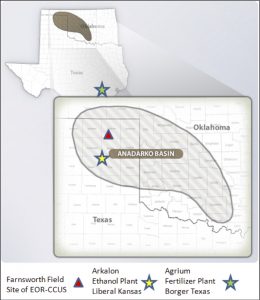 This project entails a partnership between SWP prime contractor New Mexico Institute of Mining and Technology (NMT), and its industrial partner, Chaparral Energy, LLC (CELLC), based in Oklahoma City, OK. Although there are many active partners in this project, the most heavily involved in addition to NMT and Chaparral include Schlumberger Carbon Services, the University of Utah, Los Alamos, Sandia, and Pacific Northwest National Labs, and the University of Missouri.
This project entails a partnership between SWP prime contractor New Mexico Institute of Mining and Technology (NMT), and its industrial partner, Chaparral Energy, LLC (CELLC), based in Oklahoma City, OK. Although there are many active partners in this project, the most heavily involved in addition to NMT and Chaparral include Schlumberger Carbon Services, the University of Utah, Los Alamos, Sandia, and Pacific Northwest National Labs, and the University of Missouri.
The field site for the SWP’s Phase III program is the Farnsworth Unit (FWU), Ochiltree County,Texas (in the Anadarko Basin of northern Texas), operated by CELLC. The FWU was first produced in the mid 1950s. Waterflooding was begun in the 1960s and now tertiary recovery efforts using CO2 from industrial sources is again increasing the amount of oil recovered from this prolific field. The EOR target is the Pennsylvanian-aged Morrow formation; a major oil and gas-producing formation in the midcontinent and southwestern U.S.
The SWP’s role at FWU is to examine a variety of ways of characterizing and modeling reservoirs to help optimize both EOR efforts and carbon storage, and to further evaluate methods of risk analysis, monitoring, verification, and accounting of CO2 use in the reservoir. SWP established surface and subsurface monitoring stations to create a baseline to compare portions of the reservoir that have not seen CO2 with areas where injection has already started. Baseline measurements include soil and water measurements as well as acquisition of 3D seismic data and vertical seismic profiles. Baselines include areas in patterns that have not seen CO2 , as well as areas where CO2 injection had already started.
Phase III
Phase III
The final phase of SWP’s carbon storage project entails the intensive study of a large CO2 flooding operation In response to the U.S. DOE/NETL’s Carbon Capture, Ut ilization, and Storage (CCUS) program objectives. In October 2013, SWP finalized plans with an industrial partner, Chaparral Energy (CELLC), to began characterization and monitoring in the Farnsworth Unit of the Texas panhandle.
At the net CO2 injection rate of 10 MMscf/d (~190,000 tonnes/yr), it will take more than five years to inject one million tonnes of CO2 into the target formation. During this time, the field operator will maintain the CO2 injection at the site, with goals of both maximizing sucess of the enhanced oil recovery project and facilitating the associated evaluation of storage capacity and CO2 monitoring efficacy. A relatively standard EOR design is anticipated. SWP will assess the storage capacity, evaluate portability of results, and analyze the applicability (transferability) of results with respect to other EOR fields. The project will also provide SWP with a unique opportunity to improve monitoring, verification and accounting (MVA) techniques.
The SWP will use a variety of techniques including monitoring, simulation and other analysis methods to evaluate the effectiveness of the storage operation. Monitoring techniques will include a variety of geophysical methods, engineering analyses, monitoring of groundwater and soil data, and detailed characterization of several wells that will have a great amount of core and log data collected specifically for this project.
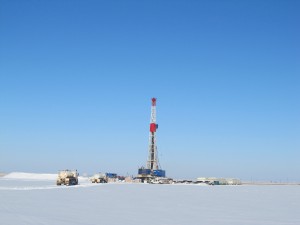
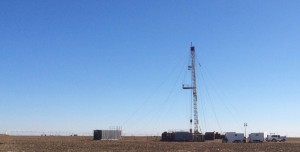
Phase II Results
Phase II Results
In Phase II the SWP carried out five field pilot tests to validate the most promising sequestration technologies and infrastructure concepts, including three geologic pilot tests and two terrestrial pilot projects. This field testing demonstrated the efficacy of proposed sequestration technologies to reduce or offset greenhouse gas emissions in the region. Risk mitigation, optimization of monitoring, verification, and accounting (MVA) protocols, and effective outreach and communication were additional critical goals of these field validation tests.
The project included geologic pilot tests located in Utah, New Mexico, Texas, and a region-wide terrestrial analysis. Each geologic sequestration test site was intended to include injection of a minimum of ~75,000 tons/year CO2, with minimum injection duration of one year. These pilots represent medium-scale validation tests in sinks that host capacity for possible larger-scale sequestration operations in the future. These validation tests also demonstrated a broad variety of carbon sink targets and multiple value-added benefits, including testing of enhanced oil recovery and sequestration, enhanced coalbed methane production and a geologic sequestration test combined with a local terrestrial sequestration pilot. A regional terrestrial sequestration demonstration was also carried out, with a focus on improved terrestrial MVA methods and reporting approaches specific for the Southwest region. The initial pilot test portfolio is summarized below.
| Pilot Test Location | Type of Pilot(s) | Amount/Duration of CO2 Injection | Key Industry / Govt. Partner(s) |
|---|---|---|---|
| Aneth Field, Paradox basin, Utah | -Deep Saline Reservoir -EOR with sequestration | ~140,000 tons per year for the two year Phae II observation period* | Navajo Nation Oil and Gas Co., Resolute |
| San Juan Basin Coal Fairway, near Navajo City, NM | -ECBM and sequestration -local-scale terrestrial sequestration via riparian restoration | ~18,400 in 378 days | ConocoPhillips , BLM, USDA |
| SACROC Unit, Permian basin, near Snyder, TX | EOR with Sequestration | >170,000 tons/yr into the pilot area, a 40 acre 5-spot pattern.** | Kinder Morgan CO2 Company, L.P. |
| Entire Southwest Region | Regional Terrestrial Analysis | N/A | -USDA |
| * Injection continues as an ongoing EOR Project | |||
| ** Injection continues as an ongoing EOR project, this is ~25% of the injection into the four corner wells into the pattern. Total injection into the four corner wells was ~680,000 tons during the first year or up to 1,360,000 tons during the first two years of injection. | |||
Five of the initial six projects were completed but the deep saline formation injection in the Aneth field was not performed due to technical problems. The EOR portion of Aneth, in a field that had not previously seen any CO2 injection, has proven to be very successful. The SWP partnership set up an MVA protocol before CO2 injection started in the geological field tests. Varying levels of success were found from these tests, which included: repeat VSP, tracer tests in the brine and CO2, passive seismic, repeat surface gas flux, and surface potential. CO2 injection continued through the two-year observation period and is planned to continue at the Aneth field for the foreseeable future.
The San Juan Basin test, in a methane-producing coalbed, has been successful in a number of areas. Injection lasted for just over a year. The injection rate had initial rates of over 200 tons/day but the injectivity soon decreased and after about six months stabilized near 30 tons/day. Thus the total injected was less than expected but is still, to date, the largest injection of CO2 into a coalbed. The associated San Juan Basin riparian restoration project comparing treated and untreated produced water has also shown promise. The MVA tests for the San Juan Basin included: repeat VSP, repeat logging, tiltmeters/GPS, tracer test, water analysis, CO2 sensors, gas sampling, and CO2 surface flux.
The third geological storage project was in the Permian Basin of Texas. Initially plans included a new CO2-EOR project in the Claytonville field with analysis of the SACROC project that has had CO2 injection ongoing since 1972. Because CO2 injection was postponed in Claytonville and was not expected to be initiated before the scheduled end of Phase II, the total emphasis was shifted to SACROC in a pattern that had had some CO2 injection earlier and was being recompleted for new and increased CO2 injection. The MVA program in the SACROC proved to be very instructive. It included: repeat VSP, repeat logging, repeat 3D, extensive water sampling and analysis, and produced fluid sampling.
The final project was a terrestrial CO2-sequestration project, which examined the entire southwest region for terrestrial analysis. This research has identified a number of approaches to have either been proven or show great potential.
Permian Basin, Texas – Enhanced Oil Recovery
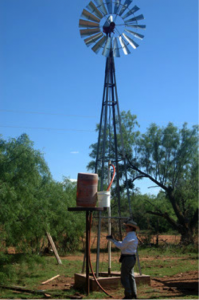
Groundwater testing at SACROC Site (Texas)
The Scurry Area Canyon Reef Operations Committee (SACROC) oil field located near Snyder, Texas is the oldest CO2 Enhanced Oil Recovery (EOR) operation in the U.S. Over the past 30 years, about 93 million tons of CO2 have been injected and about 38 million tons have been produced and reinjected. A simple mass balance suggests that the site has accumulated about 55 million tons of CO2.This location was used to validate the CO2measurement, monitoring and verification (MMV) systems that are an important part of the SWP’s field tests.
Download the Final Report (PDF, 17 MB)
Phase II
Phase II – Validation
The Validation Phase of the RCSP effort (2005– 2009) focused on evaluating promising CO2 sequestration opportunities through a series of small scale field tests in the seven partnership regions. For the Validation phase, the SWP conducted five field tests—three geologic and two terrestrial—all at various stages of planning and execution. Each test was designed to validate the most promising carbon sequestration technologies and infrastructure concepts.
This field testing demonstrated the efficacy of proposed sequestration technologies to reduce or offset greenhouse gas emissions in the region. Risk mitigation, optimization of monitoring, verification, and accounting (MVA) protocols, and effective outreach and communication were additional critical goals of these field validation tests. The program included geologic pilot tests located in Utah, New Mexico, Texas, and a region-wide terrestrial analysis. Each geologic sequestration test site was intended to include injection of a minimum of ~75,000 tons/year CO2, with minimum injection duration of one year. These pilots represent medium-scale validation tests in sinks that host capacity for possible larger-scale sequestration operations in the future. These validation tests also demonstrated a broad variety of carbon sink targets and multiple value-added benefits, including testing of enhanced oil recovery and sequestration, enhanced coalbed methane production and a geologic sequestration test combined with a local terrestrial sequestration pilot. A regional terrestrial sequestration demonstration was also carried out, with a focus on improved terrestrial MVA methods and reporting approaches specific for the Southwest region.
More details can be found on the following pages:
Phase II Results Summary
Phase II Fact Sheet (PDF, 2 MB)
Phase II Final Report (PDF, 17 MB)
Paradox Basin, Utah – Enhanced Oil Recovery
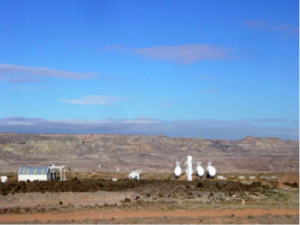
Aneth EOR Field (Utah)
The Aneth oil field is located near Bluff, Utah and is one of the largest oil fields in the nation. This site is perfect for the EOR method. Because the oil field is located on Navajo Nation land, mineral royalties go to the Navajo nation and are utilized in many ways, including a scholarship fund.
Phase I Executive Summary
Phase I Executive Summary
The Southwest Regional Partnership on Carbon Sequestration (SWP) region includes Arizona, Colorado, New Mexico, Oklahoma, Utah, and contiguous areas from three adjacent states, including western Texas, southern Wyoming, and western Kansas. This region is a net exporter of electricity, coal, oil and gas, and has some of the largest growth rates in the nation.
The Partnership characterized the region’s geologic and terrestrial sequestration attributes and options, including ranges of storage capacities of each option. The Partnership also evaluated and summarized CO2 sources in the region, and associated separation and capture technologies employed in the region. Measurement, mitigation and verification (MMV) options were evaluated, and a suite of most appropriate MMV options for Phase II validation testing was assembled. Outreach and education of the public was initiated, using a range of communication approaches, including websites, townhall meetings and conferences. The resulting data from all SWP analyses were compiled and published in comprehensive databases, with public online access; these data were also propagated to NATCARB.
The southwest region possesses an extensive CO2 pipeline network that transports over 30 Mt of naturally-sourced CO2 per year from the central Rockies to the Permian basin for EOR operations. In the Partnership’s Phase I project, we concluded that the most convenient and practical opportunities for sequestration would be to supplant the natural CO2 in these pipelines with power-plant-sourced CO2. We maintain this idea and suggest that “first options” for the nation may lie along existing pipelines. Furthermore, the SWP’s Phase I ranking of sequestration opportunities considered proximity to sources and/or pipeline infrastructure in addition to economic, safety, risk mitigation potential, and other factors. The result of the Phase I ranking process produced plans for a technology validation program that includes four geologic pilot tests located among Utah, New Mexico, and Texas, in addition to a region-wide terrestrial analysis and a local-scale terrestrial pilot test. The Phase I project recommended geologic sequestration test sites to inject a minimum of ~75,000 tons/year CO2, with a minimum injection duration of one year. Such pilots represent medium-scale validation tests in sinks that may host capacity for possible larger scale sequestration operations in the future. These validation tests will also demonstrate a broad variety of carbon sink targets and multiple value-added benefits, including testing of deep saline sequestration, enhanced oil recovery and sequestration, enhanced coalbed methane production and a geologic sequestration test combined with a local terrestrial sequestration pilot. The local terrestrial pilot involves restoration of riparian lands for sequestration purposes, using desalinated waters produced from our scheduled enhanced coalbed methane / CO2 sequestration pilot project. The Partnership’s regional terrestrial sequestration pilot program will focus on improved terrestrial MMV methods and reporting approaches specific for the Southwest region. In sum, the SWP’s Phase I project produced a field validation testing program that will seek to maximize specific performance, economic, and environmental goals of the DOE Carbon Sequestration Roadmap. This validation-testing will demonstrate efficacy of sequestration technologies to reduce or offset greenhouse gas emissions in the region. Risk mitigation, optimization of MMV protocols, and effective outreach and communication are additional critical goals of these field validation tests.
The SWP comprises a diverse group of expert organizations specializing in carbon sequestration science and engineering, as well as economics, public policy and outreach. These partner organizations are drawn from: 1) industry, 2) State governmental agencies and universities, 3) U.S. Federal government entities, and 4) other specialized partners, including the Western Governors Association. The Southwest Partnership continues a close alliance with the other Regional Partnerships, and the Western Governors’ Association has facilitated communication and collaboration. For Phase II, the Southwest Partnership is collaborating with Big Sky Partnership and WESTCARB on two different pilot tests in the region.
This report outlines the general results of the Phase 1 SWP program, which focused on characterization of the region and its sequestration options. Also included is a series of appendices, which are intended as stand-alone documents; these appendices include descriptions of the general regulatory frameworks in the Southwest region (by state), a summary of carbon sources in the region, a summary of the SWP risk factors assessment, a summary of monitoring technologies and gaps in coverage, a summary of activities conducted by the Western Governors Association on behalf of the SWP, and the action plans for the SWP Phase 2 sequestration validation program.
Download the Final Report(PDF, 19 MB)
Phase I
Phase I – Characterization
Characterization Phase (2003-2005): The Southwest Partnership on Carbon Sequestration completed its Phase I program in December 2005. The main objective of the Southwest Partnership Phase I project was to evaluate and demonstrate the means for achieving an 18% reduction in carbon intensity by 2012. During Phase I, SWP characterized the region’s geologic and terrestrial sequestration attributes and options, including ranges of storage capacities of each option. The Partnership also evaluated and summarized CO2 sources in the region, and associated separation and capture technologies employed in the region. More information can be found in the expanded Project Description page, the Phase I Executive Summary, Fact Sheet (PDF, 480 KB) or the Final Report (PDF, 19.2 MB) or Report Appendices.
Results of the Southwest Partnership’s Phase I evaluation suggested that the most convenient and practical “first opportunities” for sequestration would lie along existing CO2 pipelines in the region. Action plans for six Phase II validation tests in the region were developed, with a portfolio that included four geologic pilot tests distributed among Utah, New Mexico, and Texas. The Partnership also planned to conduct a regional terrestrial sequestration pilot program focusing on improved terrestrial MMV methods and reporting approaches specific for the Southwest region. The sixth and final validation test consisted of a local-scale terrestrial pilot involving restoration of riparian lands for sequestration purposes, using desalinated waters produced from one of the geologic pilot tests.
